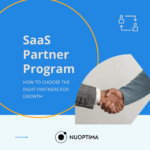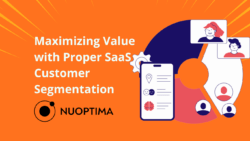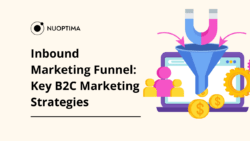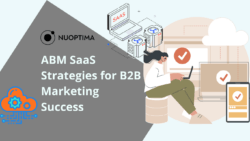Introduction
For B2B SaaS (software as a service), customer retention is the key to long-term success. Getting an in-depth understanding of customer churn offers a clear insight into how well a SaaS business is doing. At its core, customer churn represents the percentage of customers who stop their software subscriptions within a specific timeframe. While it’s a straightforward metric to calculate, it greatly impacts the success of SaaS products and the overall company.
Understanding customer churn is similar to reading the pulse of a business and as a SaaS SEO agency, we have the experience to advise you. A low churn rate for SaaS often indicates satisfied customers, while a high rate might signal underlying issues. However, the problem lies in defining the threshold of what is considered “high”. With the SaaS industry being so diverse, benchmarks can vary, making it crucial to contextualise churn rates.
The challenge is not just in quantifying churn but in interpreting its ramifications. Is a certain churn rate a mere industry standard or a red flag? Deciphering this requires a deep understanding, one that goes beyond sheer numbers. It’s about comprehending the multifaceted dynamics of customer behaviour, industry standards, and the evolving nature of SaaS offerings.
In the subsequent sections, we’ll examine the benchmarks of churn rates, offering insights to guide B2B SaaS enterprises in their journey towards customer-centric growth and improved customer retention.
What Is Churn Rate?
Churn rate, a term frequently talked about in the B2B SaaS industry, encapsulates the proportion of subscribers who terminate their subscriptions within a specific period. It serves as a barometer, gauging the health and vitality of a SaaS enterprise.
At its essence, the churn rate offers insights into customer satisfaction and the overall appeal of a service. A heightened churn rate might indicate potential issues in service delivery, product functionality, or customer support, while a reduced rate suggests that a company is meeting, if not exceeding, its subscribers’ expectations.
However, it’s pivotal to distinguish between two facets of churn: customer churn and revenue churn.
- Customer Churn: This metric reflects the number of customers or subscribers who cease their subscription during a given time frame. It provides a clear picture of subscriber retention and is often expressed as a percentage. For instance, if 10 out of 100 subscribers discontinue their service in a month, the customer churn rate for that month is 10%.
- Revenue Churn: While customer churn focuses on the number of subscribers, revenue churn delves into the monetary aspect. It represents the lost revenue due to customers discontinuing or downgrading their subscriptions. It’s crucial to note that revenue churn can sometimes be offset by upsells or cross-sells to existing customers. For instance, if a company loses £1,000 in revenue from departing customers but gains £500 from existing customers upgrading their plans, the net revenue churn is £500.
For B2B SaaS businesses, understanding both these metrics is essential. While customer churn offers a quantitative perspective, revenue churn provides insights into the financial implications of those departures. Together, they paint a complete picture, enabling SaaS enterprises to refine their offerings and strengthen their position in the industry.
Why Churn Matters for B2B SaaS Companies

The churn rate significance for B2B SaaS is complex, influencing not just immediate revenue but also shaping the trajectory of long-term business viability. Below are some main reasons why churn is pivotal for B2B SaaS.
1. Impact on Recurring Revenue
The B2B SaaS model thrives on the principle of recurring revenue. Unlike traditional sales models where revenue is a one-time transaction, SaaS companies rely on periodic subscriptions. Churn directly impacts this foundation. When a business subscriber discontinues their service, the immediate revenue is lost, and the future revenue that the subscriber would have brought in is also threatened. Over time, even a slight increase in churn can lead to substantial revenue leakage, affecting the company’s financial success.
2. Significance for Long-Term Business Sustainability
Beyond immediate financial implications, churn also casts shadows on the long-term sustainability of a SaaS enterprise. High churn rates can indicate deeper systemic issues. Perhaps the service isn’t scaling as per the needs of the clients, or maybe competitors are offering more value at a similar price point. Persistent churn can deter potential investors, affect company morale, and even influence other subscribers’ perceptions, leading them to reconsider their association with the company.
3. Churn as a Barometer for Product-Market Fit
One of the most insightful aspects of churn lies in its ability to indicate product-market fit. If a B2B SaaS company observes that its churn rate is consistently high across different sectors or demographics, it might be time to re-evaluate the product or service offering. Are there features that subscribers frequently ask for but aren’t available? Or perhaps the current software has outgrown its initial market and needs to adapt to cater to a more mature or diverse audience? In this context, churn can be a valuable feedback mechanism, guiding product development and refinement.
While churn is a metric, its implications are strategic. For B2B SaaS companies aiming to carve a niche and sustain in a competitive environment, understanding and addressing churn is the difference between success and failure.
Calculating Customer Churn Rates for B2B SaaS Companies
B2B SaaS companies typically employ a straightforward formula to calculate the customer churn rate. They divide the number of customers they’ve lost during a set period (be it a month, a quarter, or a year) by the total number of customers they had at the beginning of that period. This quotient is then multiplied by 100 to get a percentage representing the churn rate.
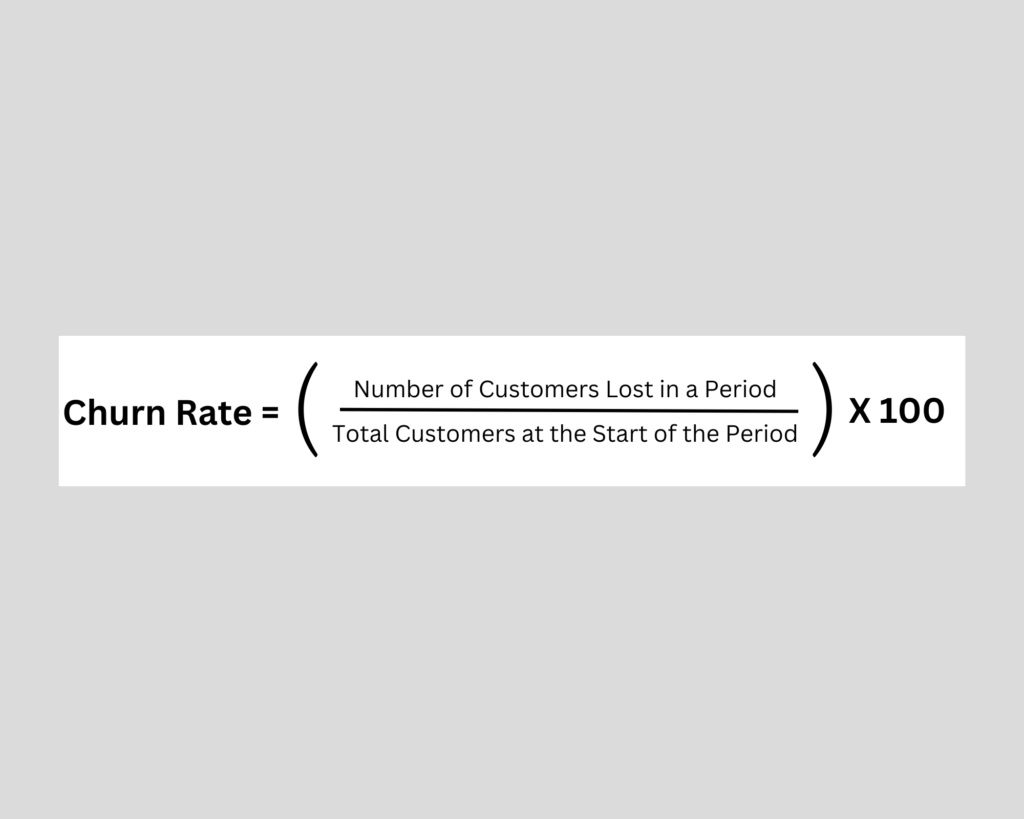
For instance, if a SaaS company starts a month with 200 subscribers and sees 20 of them leave by the month’s end, the churn rate for that month would be 10%. This means that 10% of the company’s customer base discontinued their service within that month.
However, it’s worth noting that while the basic formula remains consistent, the nuances can vary. Some companies might factor in new customers acquired during the period, while others might focus solely on the customers they had at the start. The period over which churn is measured can also vary, with some companies preferring a monthly view while others opt for quarterly or annual assessments.
As much as understanding the basic churn rate is useful, it’s essential to realise that churn can also be viewed from a revenue perspective. The revenue churn rate can be calculated as follows:
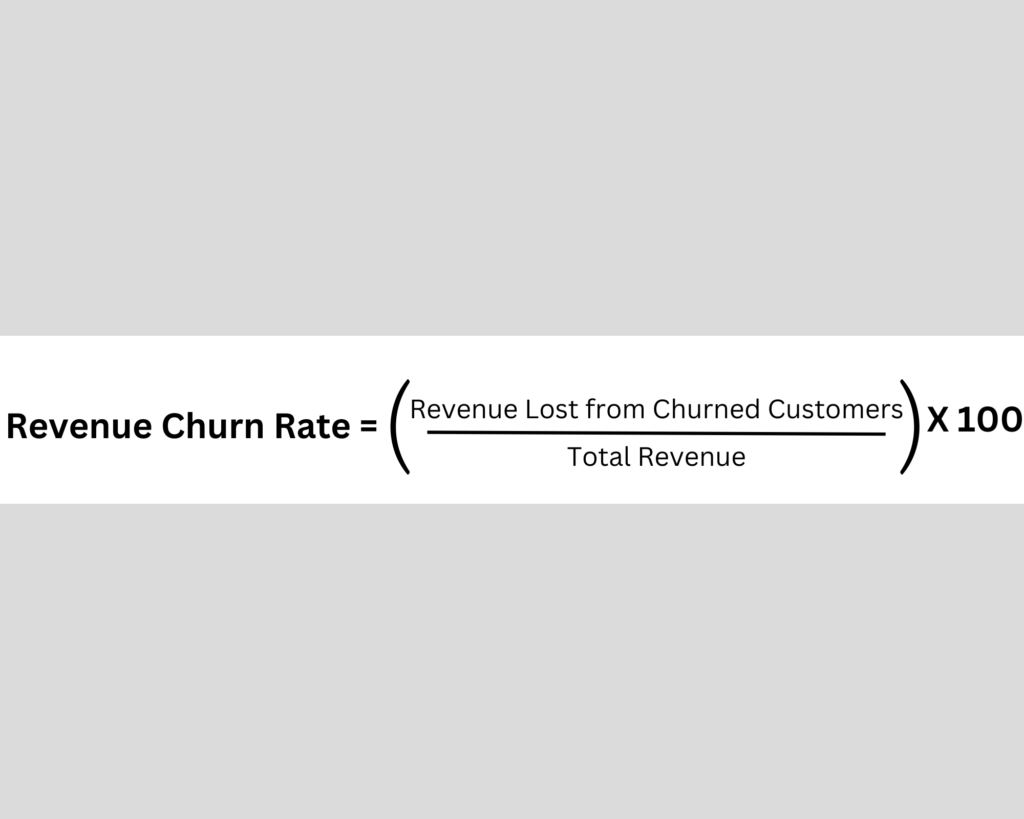
For instance, if a company began the month with £10,000 in revenue and lost £1,000 due to churned customers, the revenue churn rate would be 10%.
Churn calculation can then be taken further to encapsulate net revenue churn. This nuanced metric considers the revenue lost from churned customers and the revenue gained from existing customers, be it through upsells, cross-sells, or service upgrades.
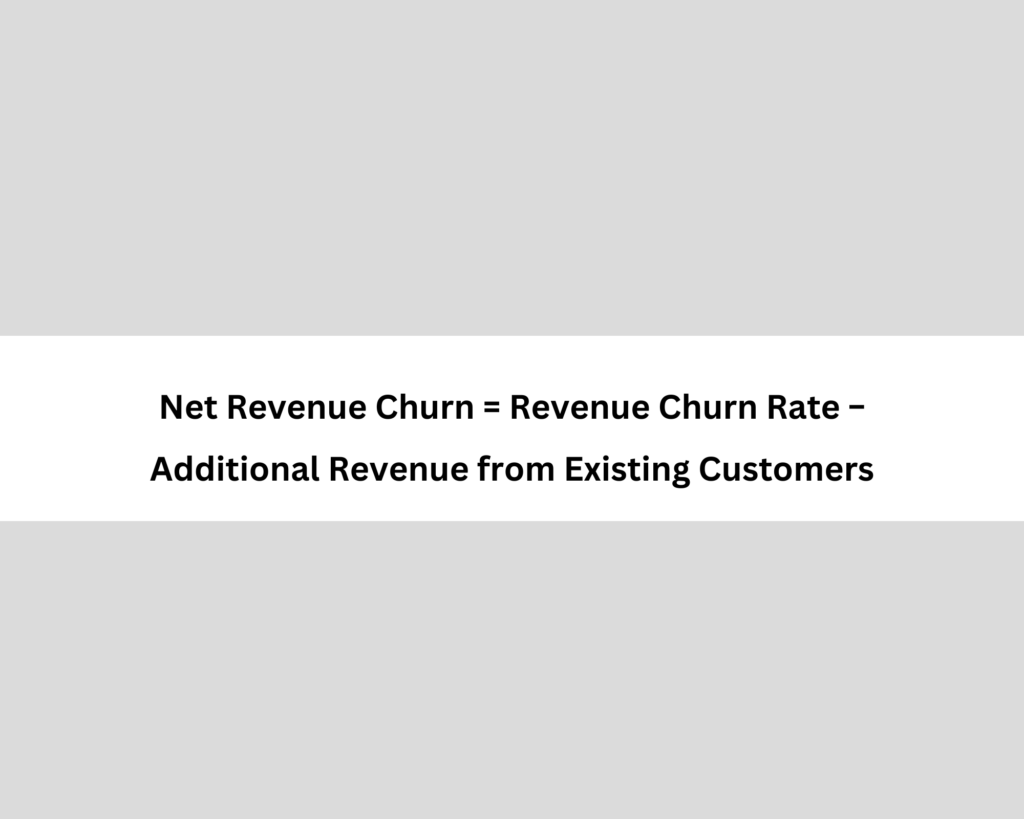
For instance, if a company’s revenue churn rate is 10%, but they gain an additional 5% in revenue from existing customers upgrading their plans, the net revenue churn would be 5%.
Net revenue churn offers a holistic view of a company’s financial soundness. A positive net revenue churn indicates that the company is retaining customers and successfully encouraging them to invest more in their services.
The Average SaaS Churn Rate
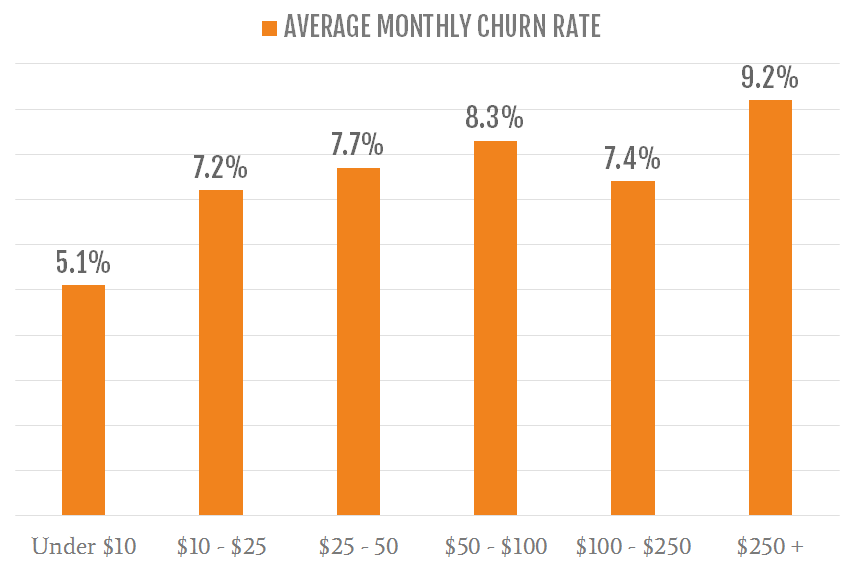
When discussing SaaS, many cite an average churn rate of around 5%, with a commendable rate being 3% or below. Yet, this figure can fluctuate based on the nature of the business and the industry it operates within. Thus, pinpointing a definitive “average” churn rate can be challenging.
The absence of a standardised B2B subscription reporting method for metrics like churn further complicates matters. Some firms focus on revenue churn, while others highlight customer or user attrition. Additionally, the clarity between monthly and annual churn figures is often lacking.
Consider the diverse findings from various surveys:
- KBCM Technology Group’s survey indicated a median annual revenue churn rate of 13.2% and a logo churn rate of 21% among its 162 participants, excluding businesses with revenue under $5m.
- Zuora’s 2019 Subscription Economy Index showcased varying average customer churn rates across sectors, with Business Services at 16.2% and Media at a higher 37.1%.
- Totango’s 2016 SaaS Metrics Report presented a broad spectrum of churn rates, with the median annual rate hovering between 5-10%.
- Nathan Latka’s website, which features interviews with founders and their SaaS metrics, indicates an average gross churn rate of 16.8% for the 300 companies listed, presumably on a monthly basis.
- Recurly, a subscription service, cites an average monthly churn rate of 5.6% from a sample of over 1,500 sites. Notably, B2C companies recorded a higher churn of 7.05% compared to B2B’s 5%.
The data shows that the average subscription churn rate, especially the average monthly revenue churn rate, spans a wide range, from 1% to 17%. However, most research seems to converge on a median monthly churn rate between 5-10%.
Industry Benchmarks for SaaS Churn
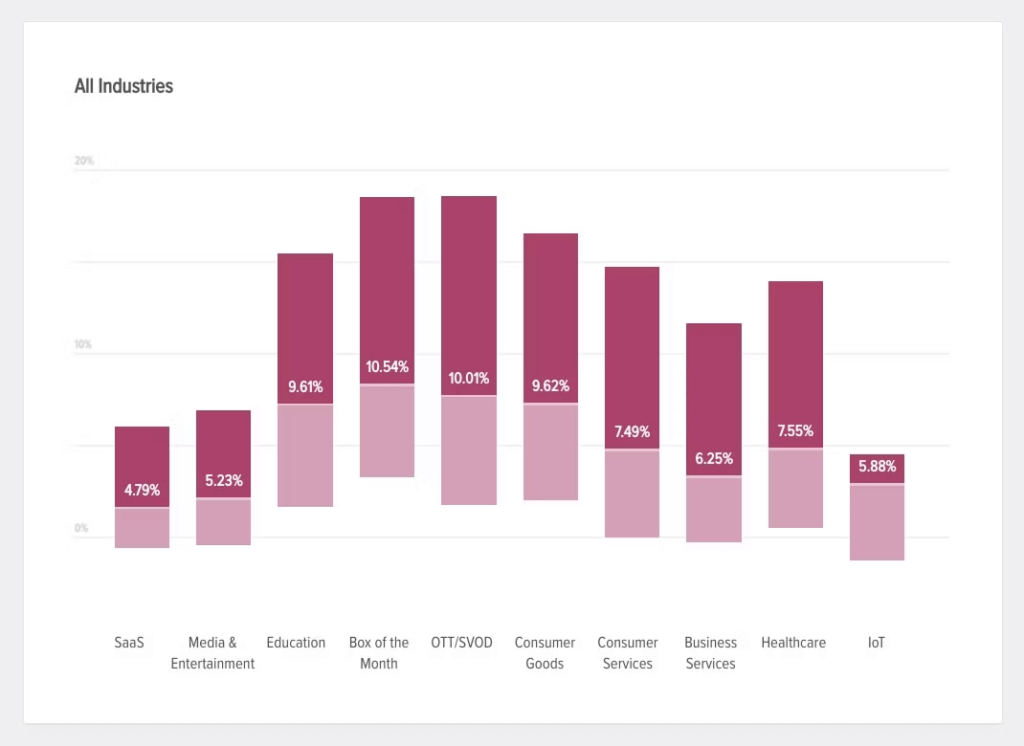
Churn rates can vary widely based on several factors, including the frequency of measurement (monthly vs annual) and specific characteristics of the company, such as its size or the nature of its product offering. Let’s explore these variations in detail.
Monthly vs Annual Churn Rate Benchmarks
Churn rate, a measure of customer attrition over time, is a crucial metric for SaaS businesses. The average churn rate in the SaaS sector is approximately 5%. However, what’s considered a “good” churn rate can be as low as 3%. It’s essential to note that these figures can vary significantly across industries and businesses.
Churn Rates Based on Company Age
The age of a company can influence its churn rate. Those that have been in operation for over a decade typically see churn rates between 2% and 4%. As companies mature, they become more adept at understanding their customers’ needs, leading to increased customer retention. Younger SaaS platforms (i.e. less than three years old) can experience a churn rate ranging from 4% to a staggering 24%.
| Company Age | Churn Rate Range |
| 10+ years | 2% – 4% |
| Less than 3 years | 4% – 24% |
Churn Rates Based on Industry
The industry of the product offering can also play a role in determining churn rates. For instance, essential software tools that businesses rely on daily might have lower churn rates compared to more niche or luxury software products. Here are some of the industry variations:
| Industry | Average Monthly Churn Rate |
| SaaS | The average churn rate for SaaS companies is around 4.8% |
| Media and Entertainment | These services have a monthly churn of approximately 5.2%. |
| Healthcare | Subscription services in this sector have a slightly higher churn rate of around 7.5%. |
| Education and Consumer Goods | Both these industries see monthly churn rates of approximately 9.6%. |
| Subscription Boxes | These have the highest churn rate, with a monthly figure of 10.54%. |
As we can see, churn rates often fluctuate based on whether the target audience is businesses or individual consumers. For instance, a SaaS product that predominantly caters to B2B offerings will usually have reduced churn. In contrast, consumer-focused services like subscription boxes or platforms like Netflix and YouTube have higher churn rates as they’re not viewed as “essential”.
Learn about maintaining brand integrity and managing online communities by tuning into the Nuoptima SaaS Podcast featuring Jenny Wolfram from BrandBastion.
Factors Influencing Churn Rates in B2B SaaS
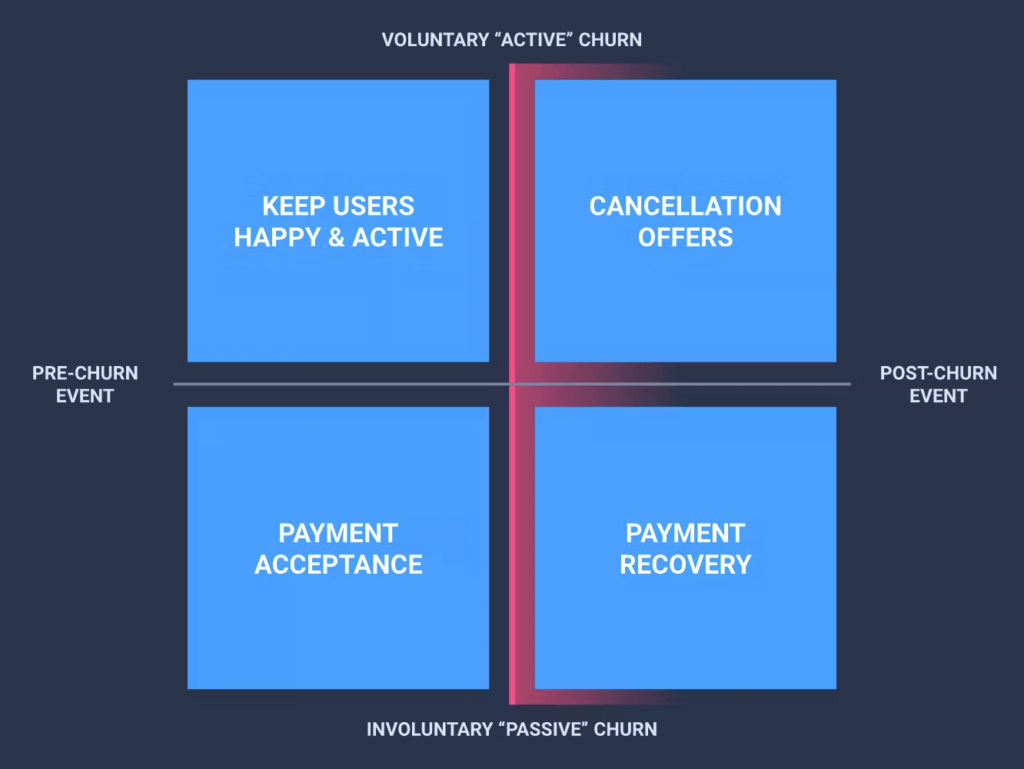
A multitude of factors shape churn rates in the B2B SaaS sector, each playing a distinct role in a customer’s decision to continue or discontinue a service. Let’s delve deeper into these factors, providing a broader spectrum of examples for each category.
Internal Factors
Understanding the factors that influence customer retention is crucial for any business. Here are some of the internal elements that can significantly impact a user’s loyalty and satisfaction with a product or service:
- Feature Set: The range and relevance of features offered can impact a customer’s decision. A product lacking essential elements or offering redundant ones may not meet the user’s needs.
- User Experience (UX): A complex or unintuitive user interface can deter customers, especially if competitors offer a more streamlined experience.
- System Downtimes: Frequent outages or system downtimes can erode trust and push customers to seek more reliable alternatives.
- Integration Capabilities: The ability of the product to seamlessly integrate with other tools and systems that a business uses can influence retention.
- Training and Onboarding: Inadequate training resources or a steep learning curve can lead to customers feeling overwhelmed and opting for more user-friendly options.
External Factors
External dynamics play a key role in shaping the success and adaptability of SaaS offerings. These are a few external influences that can impact the desirability and viability of a SaaS product in the market:
- Regulatory Changes: New regulations or compliance requirements in an industry might necessitate features or security standards that a SaaS product doesn’t offer.
- Economic Climate: Economic downturns or recessions can lead businesses to cut down on expenses, affecting subscription-based services.
- Shifts in Technology: The emergence of new technologies might render certain SaaS products obsolete or less desirable.
- Geopolitical Factors: Events like trade wars or diplomatic tensions can influence international business operations, affecting subscriptions, especially in global SaaS platforms.
- Cultural Preferences: In some regions or industries, cultural nuances might lead to preferences for localised solutions over global ones.
Voluntary Churn
Voluntary churn arises from deliberate decisions that businesses make based on evolving needs or strategies. Here are the common reasons why companies might choose to discontinue their association with specific SaaS products:
- Changing Business Models: A company might pivot to a new business model where the SaaS product is no longer relevant.
- Internal Reorganisation: Mergers or internal restructuring might lead to adopting new tools and discontinuing others.
- A shift in Strategy: A change in strategic direction might necessitate different tools and software.
Involuntary Churn
Involuntary churn occurs when external factors, often beyond a company’s immediate control, lead to the end of a service. Some typical causes that can inadvertently result in businesses discontinuing their use of a SaaS product are as follows:
- Payment Failures: Issues like expired credit cards or failed direct debits can lead to unintentional service discontinuation.
- Contractual Disputes: Disagreements over contract terms, renewals, or licensing can result in service termination.
- Security Concerns: If a business perceives potential security vulnerabilities in a SaaS product, they might be forced to discontinue its use.
As you can see, the factors influencing churn in B2B SaaS are multifaceted and can range from product-specific issues to broader external challenges. Recognising and addressing these factors can help B2B SaaS companies in improving their retention strategies.
Strategies to Minimise Churn
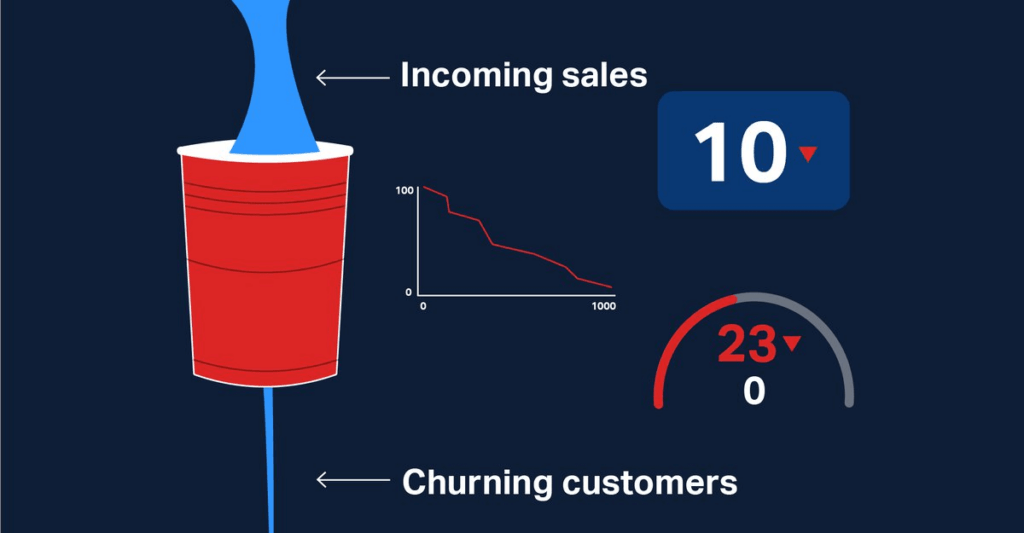
While a natural part of the business cycle, churn can be mitigated through strategic efforts. Below are some of the main strategies that can be employed to minimise churn:
Enhancing Product Experience and Value Proposition
The core of any SaaS offering is the product itself. Ensuring that it consistently meets and exceeds user expectations is paramount. This involves regular updates to address user needs, refining features for simplicity, and ensuring the product aligns with its promised value. A clear value proposition communicates the tangible benefits users receive, reinforcing their decision to continue the service.
Effective Onboarding Processes
A user’s initial interaction with a product can set the tone for their entire journey. Streamlined onboarding processes that guide users through the product’s functionalities can reduce the initial overwhelm. This might include tutorials, webinars, or even one-on-one training sessions, ensuring users feel equipped to make the most of the product from the outset.
Proactive Customer Support and Feedback Mechanisms
Rather than waiting for issues to arise, proactive customer support anticipates and addresses potential challenges in advance. This could be through FAQs, knowledge bases, or preemptive communication. Additionally, establishing channels for customers to provide feedback allows companies to gain insights into areas of improvement, making users feel valued and heard.
Utilising In-App Guidance and Interactive Walkthroughs
In-app guidance tools, such as tooltips or pop-ups, can assist users in real time as they navigate the platform. Interactive walkthroughs can be particularly beneficial for introducing new features or updates, ensuring users understand and adopt new functionalities without friction.
Importance of Data-driven Insights for Personalised UX
Understanding user behaviour is key to offering personalised experiences. Companies can identify patterns, preferences, and pain points by analysing user interactions with the product. These insights can then inform feature development, communication strategies, and even pricing models, ensuring that the product and its associated services align closely with individual user needs.
Strategy Summary
Below is a table that summarises the main strategies for reducing churn, providing a snapshot that can be easily referred to.
| Strategy | Description |
| Enhancing Product Experience | Regular updates, feature refinement, and alignment with promised value. |
| Effective Onboarding Processes | Streamlined onboarding with tutorials, webinars, or training. |
| Proactive Customer Support & Feedback | Anticipate challenges, provide FAQs, and establish feedback channels. |
| Utilising In-App Guidance and Walkthroughs | Use tooltips, pop-ups, and interactive walkthroughs for user assistance. |
| Data-driven Insights for Personalised UX | Analyse user interactions to inform feature development, communication, and pricing, aligning with user needs. |
By prioritising user experience and continuously adapting to their needs, B2B SaaS companies can foster customer loyalty and reduce the likelihood of churn.
Tools and Resources to Monitor and Reduce Churn
In the realm of B2B SaaS, understanding and mitigating churn is a pivotal concern. Several tools have been developed to address this, each offering unique functionalities to help companies monitor user interactions, gather feedback, and implement retention strategies. Let’s delve into some of these tools:
| Tool | Primary Functionality | Overview |
| Userpilot | User Onboarding and Product Adoption | Assists in crafting in-app experiences and guiding users through product features. |
| Hotjar | Heatmaps and User Feedback | Offers visual insights into user interactions, highlighting areas of engagement on a platform. |
| Mixpanel | Product Analytics | Analyses user interactions with a product, tracking events and user journeys. |
| Intercom | Customer Messaging | Facilitates real-time communication, allowing instant feedback and query resolution. |
| ChurnZero | Churn Analysis | Focuses on user engagement, offering insights into patterns that might indicate potential churn. |
| Typeform | Surveys and Feedback | Enables the crafting of interactive surveys, capturing user sentiments and feedback. |
Following the exploration of these tools, the next step is to understand some of the methodologies they employ:
- Heatmaps – Offered by tools like Hotjar, heatmaps provide a visual representation of user activity. By identifying areas of high and low engagement on a platform, companies can make informed decisions about where to place key features or where refinements might be needed.
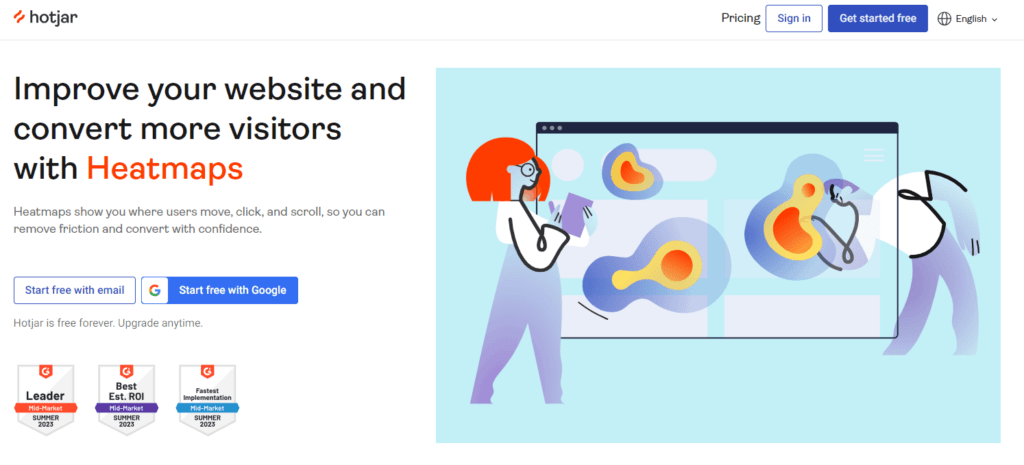
- NPS Surveys – A cornerstone of customer feedback, Net Promoter Score (NPS) surveys measure the likelihood of users recommending a product to others. Regularly gauging this metric using tools like Typeform provides companies with a clear indicator of user satisfaction and areas where improvements might be warranted.
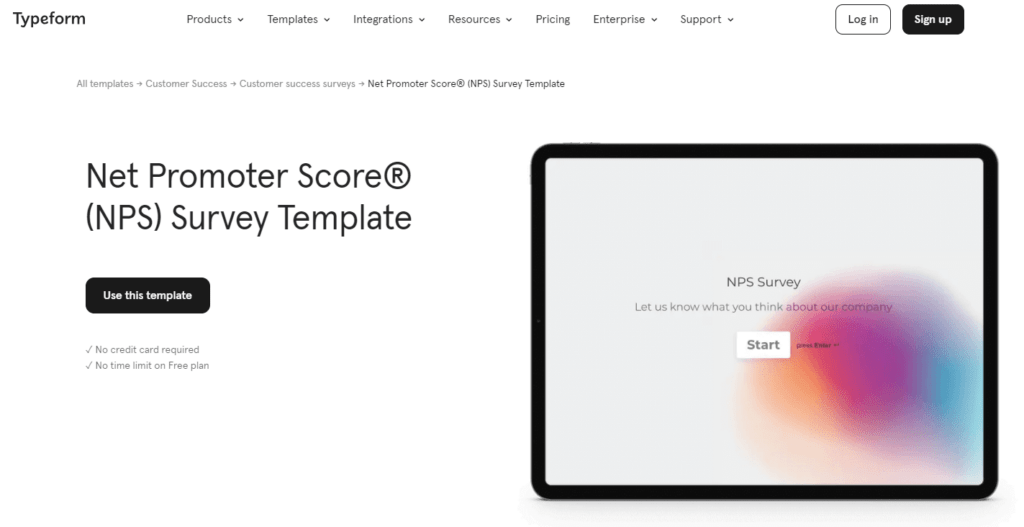
- Feedback Collection – Direct communication channels, such as those provided by Intercom, are invaluable. They offer companies real-time insights into user sentiments, allowing for immediate action on pressing concerns or the identification of emerging needs.
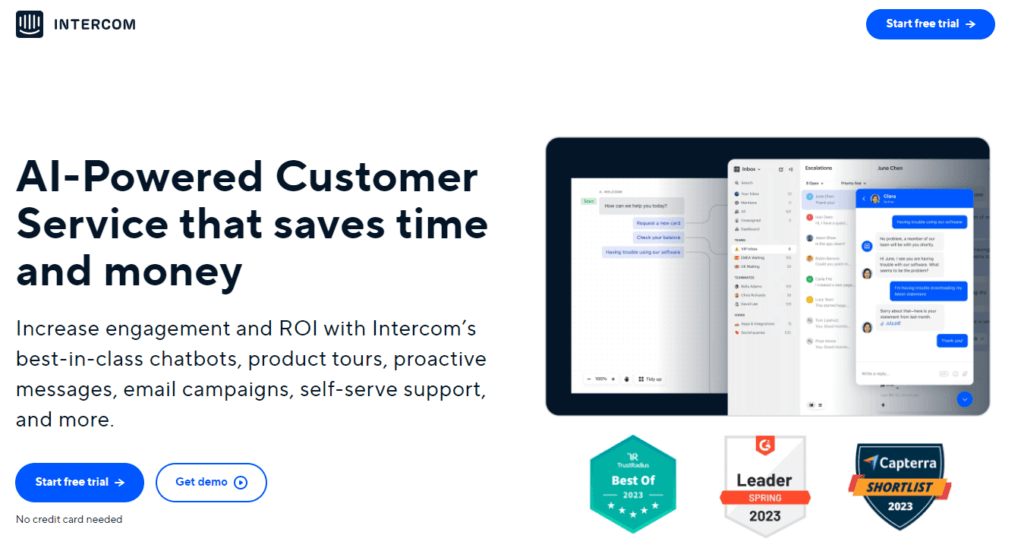
The right combination of tools and methodologies can offer B2B SaaS companies a comprehensive view of their user base’s sentiments, enabling them to take proactive measures to reduce churn and enhance overall user satisfaction.
How Growth Agencies Can Help
Reaching out to specialised growth agencies can also be a good option for those unsure of how to improve customer churn. By working with expert consultants who possess in-depth knowledge of the SaaS industry and a clear understanding of the churn trends for your market, you can continue to focus on developing your software solutions instead of worrying about improving retention.
NUOPTIMA is an experienced B2B growth agency that has worked with a number of successful tech companies. Our team understands the challenges and strategies needed to retain customers within the SaaS sector. Book a free discovery call to find out how we can help attract more subscriptions for your software products and get your churn rates to the lowest levels possible.
The Takeaway
In the complex landscape of B2B SaaS, addressing churn is not a one-time effort but a sustained commitment. While benchmarks provide a framework for understanding where a business stands, the ongoing efforts to enhance user experience and value truly make a difference.
Central to these efforts is the adoption of customer-centric strategies. Businesses can reduce churn and pave the way for sustainable growth by placing the user at the heart of every decision. It’s this unwavering attention to the needs and feedback of customers that ensures a company’s offerings remain relevant, valuable, and in line with market dynamics. Partnering with a specialized SaaS PR agency can further amplify these efforts, providing the tools and expertise necessary for B2B SaaS companies to navigate the challenge of churn and foster enduring relationships with their user base.
